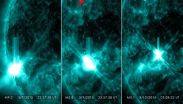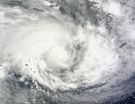(Press-News.org) MOUNTAIN VIEW, Calif., March 10, 2015 -- Today marked the publication of the first ever genome-wide association study of rosacea, a common and incurable skin disorder. Led by Dr. Anne Lynn S. Chang of Stanford University's School of Medicine, and co-authored by 23andMe, the study is the first to identify genetic factors for this condition.
Rosacea (pronounced roh-ZAY-sha) is estimated to affect more than 16 million people in the United States alone1. Symptoms typically include redness, visible blood vessels, and pimple-like sores on the skin of the central face, and many experience stinging, burning, or increased sensitivity over the affected skin. Because rosacea affects facial appearance, it can also have a psychological impact on those who suffer from it. In surveys by the National Rosacea Society, more than 76 percent of rosacea patients said their condition had lowered their self-confidence and self-esteem.
To help better understand the genetics of rosacea, researchers at Stanford University and 23andMe studied the data of more than 46,000 23andMe customers* consented for research. The study, published in the Journal of Investigative Dermatology, found two genetic variants strongly associated with the disease among people of European ancestry.
Further, the study uncovered that the genetic variants, or single nucleotide polymorphisms (SNPs), found to be strongly associated with rosacea are in or near the HLA-DRA and BTNL2 genes, which are associated with other diseases, including diabetes and celiac disease.
The genome-wide association study was broken into two parts: discovery and validation. First, data voluntarily submitted by 22,000 23andMe customers was examined. More than 2,600 customers reported having received a rosacea diagnosis from a physician. The remainder of the study participants did not have the condition and were treated as controls. To validate findings from this initial group, 23andMe researchers then tested the identified SNPs with a separate group of 29,000 consented 23andMe customers (3,000 rosacea patients, 26,000 controls). The researchers were able to confirm the same association with rosacea.
"This is another example of how 23andMe can help in researching common yet poorly understood diseases," said Joyce Tung, Ph.D., 23andMe's director of research and a co-author of the paper. "The study also speaks to the power of large data sets in studying and identifying genetic associations."
In addition to the genome-wide association study, the research included obtaining skin biopsies from six individuals with rosacea and showed that both HLA-DRA and BTNL2 proteins can be found in the skin of people with rosacea. This preliminary work hints toward the biological relevance of HLA-DRA and BTNL2 in rosacea.
INFORMATION:
Full paper citation and availability: Assessment of the Genetic Basis of Rosacea by Genome-Wide Association Study
Authors: Anne Lynn S. Chang2, Inbar Raber2, Jin Xu2, Rui Li2, Robert Spitale2, Julia Chen2, Chao Tian3, David A Hinds3, Joyce Tung3, Amy K Kiefer4, and Nicholas K Eriksson4.
1. National Rosacea Society
2 Stanford University School of Medicine, Department of Dermatology
3 23andMe, Inc.
4 Formerly of 23andMe, Inc.
*Data was contributed by 23andMe customers who provided informed consent to take part in this research under a protocol approved by the AAHRPP-accredited institutional review board, Ethical and Independent Review Services.
About 23andMe
23andMe, Inc. is the leading personal genetics company. Founded in 2006, the mission of the company is to help people access, understand and benefit from the human genome. 23andMe has over 850,000 customers worldwide with over 80 percent consented to participate in research. 23andMe is located in Mountain View, CA. More information is available at http://www.23andMe.com.
ANN ARBOR--Each year, millions of people lose billions of dollars in NCAA March Madness basketball pools. Still, most return the following year for another pummeling.
But flipping a coin yields better results than carefully selecting brackets, says Dae Hee Kwak, assistant professor of sport management at the University of Michigan School of Kinesiology.
"I completed my own (informal) bracket alongside our study by literally flipping a coin 63 times," Kwak said. "I wanted to see if this outperformed the hard thought-out selections made by the study participants in ...
The sugar industry used several tactics to influence the setting of research priorities for the 1971 US National Caries Program (NCP), according to a study published by Cristin Kearns, Stanton Glantz and Laura Schmidt from the University of California San Francisco, US, in this week's PLOS Medicine.
The researchers analyzed an archive of 319 internal sugar industry documents from 1959 to 1971 (the "Roger Adams papers") and US National Institute of Dental Research (NIDR) documents to explore how the sugar industry sought to influence the setting of research priorities ...
A newly discovered cache of industry documents reveals that the sugar industry worked closely with the National Institutes of Health in the 1960s and '70s to develop a federal research program focused on approaches other than sugar reduction to prevent tooth decay in American children.
An analysis of those papers by researchers at UC San Francisco appears March 10, 2015 in the open-source scientific journal, PLOS Medicine.
The archive of 319 industry documents, which were uncovered in a public collection at the University of Illinois, revealed that a sugar industry ...
A new technique for creating artificial DNA that is faster, more accurate and more flexible than existing methods has been developed by scientists at Imperial College London.
The new system - called BASIC - is a major advance for the field of synthetic biology, which designs and builds organisms able to make useful products such as medicines, energy, food, materials and chemicals.
To engineer new organisms, scientists build artificial genes from individual molecules and then put these together to create larger genetic constructs which, when inserted into a cell, will ...
Most military battlefield casualties die before reaching a surgical hospital. Of those soldiers who might potentially survive, most die from uncontrolled bleeding.
In some cases, there's not much medics can do -- a tourniquet won't stop bleeding from a chest wound, and clotting treatments that require refrigerated or frozen blood products aren't always available in the field.
That's why University of Washington researchers have developed a new injectable polymer that strengthens blood clots, called PolySTAT. Administered in a simple shot, the polymer finds any unseen ...
How much does health care really cost?
UCLA researchers have for the first time described cost across an entire care process for a common condition called benign prostate hyperplasia (BPH) using time-driven activity-based costing. They found a 400 percent discrepancy between the least and most expensive ways to treat the condition.
The finding takes on even further importance as there isn't any proven difference in outcomes between the lower and higher cost treatments, said study first author Dr. Alan Kaplan, a resident physician in the UCLA Department of Urology.
"The ...
Researchers at the UCLA Henry Samueli School of Engineering and Applied Science and the Université Pierre et Marie Curie in Paris have identified a method for manufacturing longer-lasting and stronger forms of glass. The research could lead to more durable display screens, fiber optic cables, windows and other materials, including cement.
Glasses are liquids that are cooled in the manufacturing process to reach a stable "frozen liquid" state. However, as glass ages and is exposed to temperature variations, it continues to flow or "relax," causing it to change shape.
This ...
The sun emitted two mid-level solar flares on March 9, 2015: The first peaked at 7:54 pm EDT and the second at 11:24 pm EDT. NASA's Solar Dynamics Observatory captured images of the flares, which were classified as an M5.8-class and an M5.1-class, respectively.
These were the second and third flares from the same active region -- numbered Active Region 12297 -- after it rotated over the left side of the sun on March 7.
INFORMATION:
...
An in-car alarm that sounds when sensors on the vehicle detect an imminent crash could cut crash rates from 1 in 5 to 1 in 10 for drivers over the of 60 suffering tiredness on long journeys, according to a study published in the International Journal of Human Factors and Ergonomics.
Psychologist Carryl Baldwin of George Mason University in Fairfax, Virginia, USA, and colleagues there and at the Sentara Norfolk General Sleep Center, emphasize how fatigue poses a persistent threat to transportation safety. Alarms that sound when a vehicle senses an imminent collision or ...
NASA's Terra satellite provided an outside look at Tropical Cyclone Pam while the RapidScat instrument that flies aboard the International Space Station provided an inside look at the surface winds generated by the storm. The GPM core satellite provided another inside look at Pam and provided data on where the heavy rainfall was occurring within the storm.
On March 9 and 10, Tropical Cyclone Pam strengthened to hurricane-force as it neared Vanuatu in the Southern Pacific Ocean.
On March 10 (11 p.m. local time), the Vanuatu Meteorology and Geo-Hazards Department (VMGD) ...


